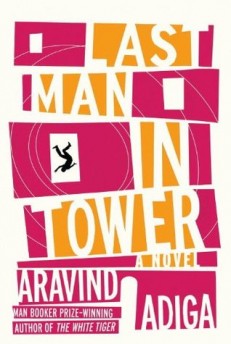 Reviewed:
Reviewed:
Last Man in Tower by Aravind Adiga
Knopf, 400 pp., $26.95
“It’s your society. Keep it clean.”
So reads a sign in the elevator of Tower A of the fictional Vishram Society apartment complex in Mumbai — the “rainwater-stained, fungus-licked grey building” that serves as the focal point of Booker Prize winner Aravind Adiga’s new novel. Decades of monsoons and erosion have left the building standing “in reasonable chance of complete collapse.” But, Adiga writes, “no one, either in Vishram Society or in the neighborhood at large, really believes that it will fall. Vishram is a building like the people living in it, middle class to its core.” Mumbai’s real estate boom is the driving preoccupation of Last Man in Tower, and Tower A, situated in the respectable but unremarkable neighborhood of Vakola, is about to become the latest building demolished to make way for bigger, shinier, pricier apartments.
Present-day Mumbai, described adoringly by Adiga, is a city alive with contradictions: “In the market by the station, mango sellers waited for the returning commuters: ripe and bursting, each mango was like a heartfelt apology from the city for the state of its trains.” It is a city teeming with inefficiencies, but also with flavor and life, and it is in the midst of a dramatic transformation: “Bombay, like a practitioner of yoga, was folding into itself, as its center moved from the south, where there was no room to grow, to this swamp land near the airport.”
As the center of the city shifts, real estate tycoon Dharmen Shah sets his sights on expanding his empire into Vakola. After sending his “left-hand man” Shanmugham to scout the property, Shah makes a generous offer: He’ll buy out each of Vishram Society’s units for nearly twice their market value to make way for the luxe Confidence Shanghai. It’s a windfall no one in the building ever dreamed of, but there is a catch. The offer only stands if everyone in the building accepts its terms. Shah and Shanmugham are experienced in coercing stubborn holdouts into approving such agreements — and they are prepared to use their usual tactics in Vakola — but this time, they hardly need to. Almost as soon as Shah’s Confidence Group announces its offer, the residents of Vishram Society’s tight-knit Hindu-Muslim-Catholic community immediately begin lobbying one another.
A potent mixture of loyalty and class envy has long been the glue of Vishram Society, and Tower A in particular. Now it becomes a powerful psychological driver. Describing one of the building’s residents, Adiga writes:
She envied Kudwa and his happy family life — just as she knew he in secret envied Ajwani for owning a Toyota Qualis; just as Ajwani probably envied someone else; and this chain of envy linked them, showing each what was lacking in life, but offering also the consolation that happiness was present right next door, in the life of a neighbor, an element of the same Society.
Their middle class aspirations are communal, and above all, material. “Who am I, Arundhati Roy?” Mrs. Rego, one of the building’s residents retorts when one of her neighbors suggests that her low-paying social work might provide the kind of fulfillment money can’t buy. It’s a subtle reflection on the zeitgeist of the last decade, the time span during which novelist-turned-crusading-activist Roy has become an international star and India has seen unprecedented economic growth. Like Adiga’s 2008 Booker-winning novel The White Tiger, his latest effort looks closely at the tensions of this new India. Now, as Adiga observes, “in Bombay caste and religion had faded away, and what had replaced them . . . was the idea of being respectable and living among similar people.” The Arundhati Roy poster on Mrs. Rego’s wall is primarily an expression of taste. No social cause can trump her desire for a bigger apartment.
In the end, there’s just one resident immune to the seduction of Shah’s offer and the promise of new money — a retired schoolteacher known simply as Masterji. A respected widower who had long ago “accepted his lot with dignity” and grown set in his ways, Masterji is an anachronism in modern Mumbai. In a city of strivers, his wants are simple. “Vishram Society Tower A is my home” he writes, “and it
Will not be sold
Will not be leased or rented
Will not be redeveloped
Simply refusing to be bought, brokered, or bullied out of his home becomes dispassionate Masterji’s defining act of civil disobedience. It’s also a position that quickly makes him a pariah among the community that had long held him in esteem. Drunk on greed, the respectable residents of Vishram Society turn on Masterji.
There are dark figures in this book — among them, Masterji’s “respectable” neighbors — but none are as unchecked, unreflective, and unrelenting, the novel insists, as modernization itself. In Last Man in Tower, the construction industry embodies the city’s naked ambition: “All of Bombay was created like this: through the desire of junk and landfill, on which the reclaimed city sits, to become something better.” There is something noble about the unceasing pursuit of betterment, but as the city transforms, it doesn’t always improve. The novel is laced with the sadness and decay of what can only be called development without foresight — a condition that belongs among Gandhi’s famous list of moral blunders, or at least in the pages of the Times of India, where Masterji reads about a building toppled by a rainstorm after its residents install heavy water tanks on its roof against the advice of the municipal engineer: “The desire for self-improvement had been the cause of destruction.”
Mythili G. Rao has written for the New York Times Book Review, Words without Borders, Publishers Weekly, and other publications.
Mentioned in this review:

